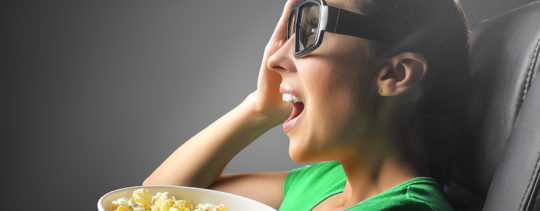
30 Aug 3D TECHNOLOGY AND YOUR VISION
3D technology has moved from the big screen, to home TV screens, and now even to personal hand held gaming devices, but have you ever wondered about the effects 3D screens are having on your eyes?
HOW IT WORKS
3D technology displays two different images on the screen that are separated by a certain distance to enhance the perception of depth within a particular scene. Wearing 3D glasses, filter the projected light to present separate images to each eye creating a 3D effect. This is why the scene on the screen will look blurry if you are not wearing the 3D glasses.
MUSCLE CONTROL AND VISION
The eye contains some of the hardest working muscles in the human body, and when you watch a 3D movie, you begin to put these eye muscles through a marathon of work. When one eye is not in sharp focus, or if the eyes are misaligned with one another it becomes difficult for a person to enjoy a 3D movie comfortably. This is referred to as Marginal Binocular Vision, which is described as the inability to use both eyes together.
Symptoms of Marginal Binocular Vision include:
- Fatigue during and after a 3D screening.
- Feeling nauseous or uneasy during and after the 3D screening.
- Developing a headache during or after the 3D screening.
EXPERIENCING THESE SYMPTOMS? HERE’S WHAT TO DO:
VISION THERAPY
Many optometrists would recommend vision therapy if you are experiencing discomfort while watching 3D movies. With vision therapy comes an individualized treatment program that is prescribed by your optometrist. Vision therapy can be specifically adjusted to help improve eye conditions like amblyopia (lazy eye) and strabismus (crossed eyes).
Some vision therapy practices use 3D stereo images as a tool to train your eyes to work together. Research has shown that the techniques of vision therapy over time, have allowed people to see more efficiently and comfortably. Some of the visual skills focused on during vision therapy are the accuracy of eye movement, the ability to focus, and eye coordination between both eyes.
GIVE YOUR EYES A REST
Apply the 20-20-20 rule. Make it a habit every 20 minutes to take a 20 second break to look 20 feet away at something other then the screen. Giving your eyes a break while watching a 3D screen will help eliminate fatigue and eye strain. This also helps with digital screens in a general sense.
CHILDREN AND 3D TECHNOLOGY
Currently there are no studies to report the long-term effects of 3D technology. However, if a child consistently gets headaches, feels fatigue or cannot see the images clearly when using 3D technology, this can be a preset indication of a vision impairment or eye disorder. This does not mean that the disorder came from the habit of watching 3D screens but it may be an indication of an underlying eye condition. With most young children these conditions are treatable as their visual systems have yet to fully develop.
If you, or your children are having problems with viewing 3D technology, book an appointment with Dr.D’Orio and Associates today for a full eye exam and to voice any concerns.


